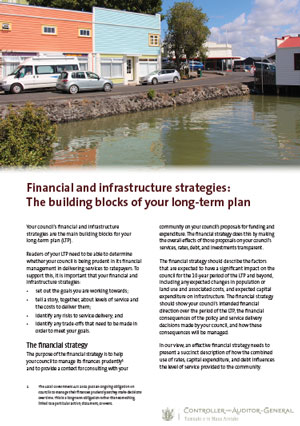Financial and infrastructure strategies: The building blocks of your long-term plan
Your council’s financial and infrastructure strategies are the main building blocks for your long-term plan (LTP).
Readers of your LTP need to be able to determine whether your council is being prudent in its financial management in delivering services to ratepayers. To support this, it is important that your financial and infrastructure strategies:
- set out the goals you are working towards;
- tell a story, together, about levels of service and the costs to deliver them;
- identify any risks to service delivery; and
- identify any trade-offs that need to be made in order to meet your goals.
The financial strategy
The purpose of the financial strategy is to help your council to manage its finances prudently1 and to provide a context for consulting with your community on your council’s proposals for funding and expenditure. The financial strategy does this by making the overall effects of those proposals on your council’s services, rates, debt, and investments transparent.
The financial strategy should describe the factors that are expected to have a significant impact on the council for the 10-year period of the LTP and beyond, including any expected changes in population or land use and associated costs, and expected capital expenditure on infrastructure. The financial strategy should show your council’s intended financial direction over the period of the LTP, the financial consequences of the policy and service delivery decisions made by your council, and how these consequences will be managed.
In our view, an effective financial strategy needs to present a succinct description of how the combined use of rates, capital expenditure, and debt influences the level of service provided to the community.
The infrastructure strategy
The purpose of the infrastructure strategy is to identify your council’s significant infrastructure issues for the period covered by your strategy and the principal options for managing those issues and the implications of those options.
The infrastructure strategy must outline how your council intends to manage its infrastructure assets, taking into account the need to:
- renew or replace existing assets;
- respond to growth or decline in demand for council services;
- allow for planned increases or decreases in levels of service (in response to things like increased health or environmental standards); and
- provide for the resilience of infrastructure by identifying and managing risks relating to natural hazards and by making appropriate financial provision for those risks.
The infrastructure strategy must also outline the most likely scenario for the management of your council’s infrastructure assets during the period of the strategy, the estimated costs of managing those assets, the nature and timing of expected significant capital expenditure decisions, and the assumptions on which the scenarios are based.
From our review of the 2018-48 infrastructure strategies, we have identified several areas where we think they could usefully improve:
- Be clear about the condition of your council’s critical assets and what this means for the management of infrastructure assets.
- Have your infrastructure strategy better integrated and/or consistent with your financial strategy.
- Clearly outline the link between assets and the services they support by better describing the levels of service.
What you need to consider when setting your financial and infrastructure strategies
As an elected member, you are responsible for setting the strategic direction reflected in your LTP, prudently managing your council’s finances, and engaging with your community on the proposed direction of travel.
This requires making informed decisions supported by advice from council staff, including considering how the current operating environment (for example, the Covid-19 pandemic, climate change impacts, and the three waters reform) could affect your council’s financial and infrastructure strategies.
Questions to consider when setting your financial and infrastructure strategies
Understanding the current operating environment and implications
- What are the trends and issues facing your local community?
- How have the expectations of your community changed?
- What are the key regulatory changes that will affect your council?
- What impact do these have on the assumptions you have made and the content of your financial and infrastructure strategies?
Financial strategy
- Are you confident that your council is taking a financially prudent approach to its LTP?
- Is the financial direction of your council described clearly in your financial strategy and presented in a way your community can engage with?
Infrastructure strategy
- Are you confident that your infrastructure strategy reflects your council’s significant infrastructure issues?
- Is your strategy clear on how the council intends to manage its infrastructure assets over the long term?
- What will affect demand for council services and the standards at which these services are delivered?
- Does your council have a good understanding of the condition and performance of its critical assets?
- Are you confident that your council can provide for the resilience of its infrastructure to mitigate the effects of natural hazards, including those exacerbated by climate change?
1: The Local Government Act 2002 puts an ongoing obligation on councils to manage their finances prudently as they make decisions over time. This is a long-term obligation rather than something linked to a particular action, document, or event.

